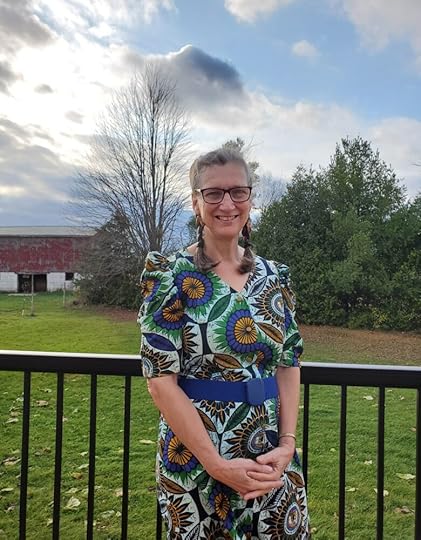Monk in the World Guest Post: Laurie vandenHurk
I am delighted to share another beautiful submission to the Monk in the World guest post series from the community. Read on for Laurie vandenHurk’s reflection on praying the Rosary.
Sometimes there are no words for prayer.
Sometimes silence just opens me to the chatter and anxiety in my brain.
A number of years ago there was a crisis in my inner circle that threw our lives into chaos. How could I support a loved one whose life just fell apart? How could I hold a supportive space for the others who are equally impacted? What do I need for my own mental health?
Since the crisis was not mine, I could not talk with others about my worries without sharing what was not mine to share.
One day I was meditating with the gospel story of the paralytic man whose friends brought him to Jesus for healing. There was a dense crowd around Jesus and they could not get near, so they went to the roof. I imagined the dried mud and straw as they dug open the flat roof and lowered their friend before Jesus. In the gospel narrative the paralysed man did not ask Jesus for healing. He did not demonstrate or confess faith in Jesus or in his healing. It was his friends who had faith that Jesus could heal him, and their faith was not misplaced. (1)
I pondered, who can I ask to join me in bringing these loved ones to Jesus for healing? I remembered the “great cloud of witnesses,” (2) those who, although they had died, were still nearby. I asked them to join me in a circle of intercession. I asked our parents, and a couple of dear friends; I asked Saints that I thought might understand the situation; I asked Mary and Joseph. The prayer was simple, “Mom, pray for ….” “Our Mother, pray for ….” I called on at least ten of them, once or twice a day.
Until then I had never consciously addressed Mary in prayer. But understanding that she was part of the circle of saints gathered around Jesus enabled me to approach her as I approached others. Until then I was uncomfortable with, and reluctant to pray the Rosary, that most beloved of prayers in which people ask for Mary’s help.
Today I would like to relate how the Rosary has become a prayer for me when I have no words, and how it has created an inner peace when I could only hear the loud worries in my head during silent meditation. (See footnote 3 for a link to the most familiar way of praying the Rosary.)
John Paul II introduced the Mysteries of Light for the Rosary. (4) The “mysteries” are gospel narratives with which I have been praying my whole life. John Paul said that the inclusion of a phrase with the name of Jesus has the potential to bring us back to the mystery of Christ on which we are meditating. Following his inspiration, in making the Rosary my own, I added a phrase after the name “Jesus.”
Now whether I pray the 5 groups of 10 (decades) of invocations to Mary, or only a few, I pray…
“Hail Mary, full of grace, the Lord is with you. Blessed are you among women and blessed is the fruit of your womb, Jesus, Risen from the Dead. Holy Mary, Mother of God, pray for us sinners, now and at the hour of our death.”
I was moved by the fluidity of the prayer. John Paul made other suggestions which I tried, like reading and reflecting on a Scripture passage before praying each decade, and concluding each decade with a different prayer related to the mystery. But my prayer lost its contemplative nature. I was too busy thinking about what I would be saying next.
I loosened the practice some more. Before beginning to pray the Rosary, I sit with what I am presently experiencing in my life. What are the great needs in my family, my community and in the world? What is troubling me? Is there a gospel narrative, like that of the paralysed man, that speaks to me of the hope that I am seeking?
The crisis in my inner circle passed. More than that, something new and unexpectedly beautiful emerged from the ashes. I recognize the resurrecting work of the Spirit in the healing that has taken place.
Sometimes I use other phrases in place of “Risen from the Dead,” such as “Prince of Peace,” or “who blesses marriages,” or “Bread for the World.” However, lately I have found that “Risen from the dead” addresses my concerns for myself and others, who are grieving, or who are struggling with mental health or addictions. It is relevant for difficult and estranged relationships. It gives me a place to rest my hopes in national and international conflicts and in care for the earth.
The Rosary is not a magic formula. We never know the outcome of our prayers. However, in this prayer, I continuously affirm my trust in the God who raised Jesus from the dead and brings hope and new life out of seemingly hopeless situations.
Matthew 9:1–8, Mark 2:1–12, and Luke 5:17–26Hebrews 12:1https://thecatholichandbook.com/how-to-pray-a-decade-of-the-rosary/https://www.vatican.va/content/john-paul-ii/en/apost_letters/2002/documents/hf_jp-ii_apl_20021016_rosarium-virginis-mariae.html
Laurie vandenHurk writes as a partner, grandparent, and care-giver from her years of experience in facilitating community development, spirituality and bereavement, with people of all ages and widely diverse circumstances, including 10 years in Tanzania. Laurie is a trained Spiritual director of The Haden Institute.
The post Monk in the World Guest Post: Laurie vandenHurk appeared first on Abbey of the Arts.



